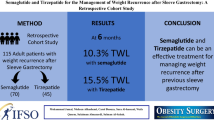Abstract
Background
The Bioenterics Intragastric Balloon (BIB) is effective for weight loss. However, comparisons of its effectiveness between groups with different body mass index (BMI) are rare. This study compared the effectiveness of BIB treatment in patients with BMI <32 kg/m2 and those with BMI ≧32 kg/m2 at the time of BIB removal and at 1 year later.
Methods
Between April 2009 and June 2011, 28 obese patients who completed a full course of BIB treatment were enrolled. There are 16 patients with BMI <32 and 12 with BMI ≧32. Patients who lost more than 20 % of excess weight (% EWL) were categorized as responders.
Results
The BMI significantly fell from 32.4 ± 3.7 to 28.5 ± 3.7 kg/m2 (P < 0.01) at the time of BIB removal. All biochemical measurements except for cholesterol level were significantly improved. The median value of %EWL of all patients at BIB removal was 40.1, and 20 patients (71.4 %) were responders. Adherence to dietitian counseling was significantly better in responders than in non-responders (85 vs. 25 %, respectively; P < 0.01). The percentage of responders at 1 year after BIB removal was significantly higher among patients with BMI <32 than those with ≧32 (62.5 vs. 16.7 %, respectively; P = 0.02).
Conclusions
BIB placement can achieve significant weight loss and improvement of co-morbidities in obese patients. Better adherence to dietitian counseling is associated with better response. Patients with BMI <32 maintain better weight loss at 1 year after BIB removal.
Similar content being viewed by others
Abbreviations
- BIB:
-
BioEnterics Intragastric Balloon
- BMI:
-
Body mass index
- WC:
-
Waist circumference
- AST:
-
Aspartate aminotransferase
- ALT:
-
Alanine aminotransferase
- HDL:
-
High-density lipoprotein
- LDL:
-
low-density lipoprotein
- LA:
-
classification Los Angeles classification
- EWL:
-
Excess weight loss
References
James WP. The epidemiology of obesity: the size of the problem. J Intern Med. 2008;263:336–52.
Delinsky SS, Latner JD, Wilson GT. Binge eating and weight loss in a self-help behavior modification program. Obesity (Silver Spring). 2006;14:1244–9.
Maggard MA, Shugarman LR, Suttorp M, et al. Meta-analysis: surgical treatment of obesity. Ann Intern Med. 2005;142:547–59.
Goldfeder LB, Ren CJ, Gill JR. Fatal complications of bariatric surgery. Obes Surg. 2006;16:1050–6.
Imaz I, Martinez-Cervell C, Garcia-Alvarez EE, et al. Safety and effectiveness of the intragastric balloon for obesity. A meta-analysis. Obes Surg. 2008;18:841–6.
Dumonceau JM. Evidence-based review of the Bioenterics intragastric balloon for weight loss. Obes Surg. 2008;18:1611–7.
Lee WJ, Wang W. Bariatric surgery: Asia-Pacific perspective. Obes Surg. 2005;15:751–7.
Mui WL, So WY, Yau PY, et al. Intragastric balloon in ethnic obese Chinese: initial experience. Obes Surg. 2006;16:308–13.
Ganesh R, Rao AD, Baladas HG, et al. The Bioenteric Intragastric Balloon (BIB) as a treatment for obesity: poor results in Asian patients. Singap Med J. 2007;48:227–31.
Ohta M, Kitano S, Kai S, et al. Initial Japanese experience with intragastric balloon placement. Obes Surg. 2009;19:791–5.
Mui WL, Ng EK, Tsung BY, et al. Impact on obesity-related illnesses and quality of life following intragastric balloon. Obes Surg. 2010;20:1128–32.
Alberti KG, Eckel RH, Grundy SM, et al. Harmonizing the metabolic syndrome: a joint interim statement of the International Diabetes Federation Task Force on Epidemiology and Prevention; National Heart, Lung, and Blood Institute; American Heart Association; World Heart Federation; International Atherosclerosis Society; and International Association for the Study of Obesity. Circulation. 2009;120:1640–5.
Lundell LR, Dent J, Bennett JR, et al. Endoscopic assessment of oesophagitis: clinical and functional correlates and further validation of the Los Angeles classification. Gut. 1999;45:172–80.
WHO Expert Consultation. Appropriate body-mass index for Asian populations and its implications for policy and intervention strategies. Lancet. 2004;363:157–63.
Deitel M, Gawdat K, Melissas J. Reporting weight loss 2007. Obes Surg. 2007;17:565–8.
Kotzampassi K, Grosomanidis V, Papakostas P, et al. 500 intragastric balloons: what happens 5 years thereafter? Obes Surg. 2012;22:896–903.
Dansinger ML, Tatsioni A, Wong JB, et al. Meta-analysis: the effect of dietary counseling for weight loss. Ann Intern Med. 2007;147:41–50.
Puglisi F, Antonucci N, Capuano P, et al. Intragastric balloon and binge eating. Obes Surg. 2007;17:504–9.
Herve J, Wahlen CH, Schaeken A, et al. What becomes of patients one year after the intragastric balloon has been removed? Obes Surg. 2005;15:864–70.
Genco A, Lopez-Nava G, Wahlen C, et al. Multi-centre European experience with intragastric balloon in overweight populations: 13 years of experience. Obes Surg. 2013;23:515–21.
Acknowledgments
This study was supported by a Project of the E-Da Hospital, Grant Number EDAHP101017.
Conflict of Interest
All contributing authors declare that they have no conflicts of interest.
Author information
Authors and Affiliations
Corresponding author
Rights and permissions
About this article
Cite this article
Tai, CM., Lin, HY., Yen, YC. et al. Effectiveness of Intragastric Balloon Treatment for Obese Patients: One-Year Follow-up After Balloon Removal. OBES SURG 23, 2068–2074 (2013). https://doi.org/10.1007/s11695-013-1027-7
Published:
Issue Date:
DOI: https://doi.org/10.1007/s11695-013-1027-7




